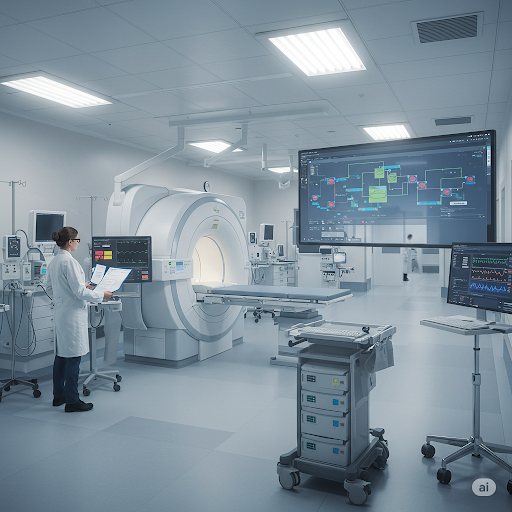Planned Maintenance refers to maintenance activities carried out on industrial systems, machinery, and infrastructure at predetermined intervals based on established schedules. This type of maintenance is conducted to prevent unexpected failures, ensure operational continuity, and extend the lifespan of assets. Planned maintenance involves not only technical interventions but also the systematic monitoring, documentation, and optimization of maintenance processes. Such practices have a direct impact on productivity, occupational safety, and cost control. In modern maintenance management, planned maintenance is considered an integral part of organizational decision-making processes.

An Engineer Planning Maintenance Processes in a Factory (Generated by Artificial Intelligence)
Classification and Characteristics of Planned Maintenance
Planned maintenance is divided into various subcategories based on its implementation method and maintenance frequency. The most common types are periodic maintenance and predictive maintenance. Periodic maintenance is performed at predetermined time intervals, typically in accordance with manufacturer recommendations. Predictive maintenance, on the other hand, relies on equipment performance data and sensor-based monitoring systems, enabling maintenance actions to be performed only when necessary.
Periodic maintenance includes scheduled inspections, lubrication, filter replacements, and the routine renewal of specific components. This system allows maintenance personnel to address operational disruptions in advance. Predictive maintenance involves the monitoring of equipment condition through techniques such as vibration analysis, thermography, ultrasonic testing, and oil analysis. These data-driven methods help identify components with potential failure risks and optimize the timing of interventions.
Planned maintenance activities are typically managed using Computerized Maintenance Management Systems (CMMS). These software tools facilitate the documentation of maintenance tasks, management of resources and inventory, and monitoring of performance indicators. CMMS platforms also enable the automatic generation of maintenance schedules and the early notification of maintenance needs. Thus, planned maintenance processes are carried out in a systematic and data-driven manner.

Computerized Maintenance Management System (Generated by Artificial Intelligence)
Industrial Applications of Planned Maintenance
Planned maintenance is widely implemented across various industrial sectors, including manufacturing, energy production, transportation systems, chemical plants, and the healthcare sector. Each industry develops unique planned maintenance strategies based on the structure and frequency of use of its equipment. For example, in energy production facilities, components such as turbines, generators, and transmission systems must operate with high reliability; therefore, planned maintenance practices in these facilities include detailed inspection procedures.
In the manufacturing sector, ensuring the continuous operation of machines along production lines is essential for maintaining production efficiency. As a result, planned maintenance in this sector is typically integrated with shift schedules and the production cycle. Synchronizing maintenance times with production planning minimizes downtime and prevents production interruptions.
In the transportation sector, planned maintenance is applied to ensure the roadworthiness and operational safety of vehicles. In areas such as railways, aviation, and road transport, vehicles are subject to regular inspections and testing based on legal requirements. These regulations ensure not only passenger safety but also the operational continuity of the transportation systems.
Planned maintenance is also used in building management, IT infrastructure, and healthcare services. In institutions that provide critical services, such as hospitals, detailed planned maintenance protocols are implemented to ensure the fault-free operation of medical devices and support systems. In such contexts, maintenance activities affect not only equipment performance but also directly impact patient safety.

Planned Maintenance for Medical Devices (AI-Generated Illustration)
Organizational and Systematic Dimension of Planned Maintenance
Planned maintenance encompasses more than just the technical responsibilities of maintenance personnel; it is also deeply connected with organizational structure, decision-making processes, and resource management. For planned maintenance to be effectively implemented, institutions must engage in strategic planning at the corporate level, allocate budgets, and prepare human and material resources in advance.
Key operational processes such as scheduling maintenance activities, prioritizing tasks, and allocating resources have a direct impact on overall organizational efficiency. Institutions typically manage maintenance work orders through Computerized Maintenance Management Systems (CMMS), making these processes traceable and reportable. Through CMMS, data is systematically recorded on intervention frequencies, replaced components, and how maintenance durations influence production performance.
Within planned maintenance organizations, integration with occupational health and safety (OHS) protocols is also critical. This integration encompasses the tools used during maintenance, standard operating procedures, and the application of personal protective equipment (PPE). In addition, ongoing training programs for maintenance personnel enhance diagnostic and intervention competencies, supporting the safe and sustainable operation of systems.
This systematic structure underscores that planned maintenance is not merely a technical application but also a fundamental element of corporate governance and organizational design. Accordingly, planned maintenance is regarded as a managerial function executed through a holistic approach across technical, organizational, and strategic levels.


